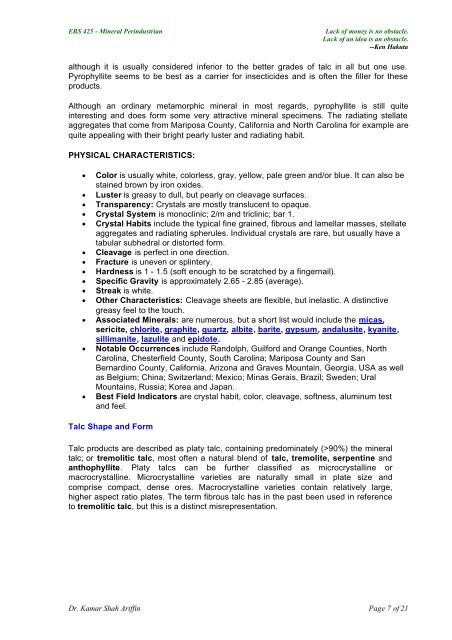Talc and pyrohyllite
Talc and pyrohyllite
Talc and pyrohyllite
You also want an ePaper? Increase the reach of your titles
YUMPU automatically turns print PDFs into web optimized ePapers that Google loves.
EBS 425 - Mineral Perindustrian Lack of money is no obstacle.<br />
Lack of an idea is an obstacle.<br />
--Ken Hakuta<br />
although it is usually considered inferior to the better grades of talc in all but one use.<br />
Pyrophyllite seems to be best as a carrier for insecticides <strong>and</strong> is often the filler for these<br />
products.<br />
Although an ordinary metamorphic mineral in most regards, pyrophyllite is still quite<br />
interesting <strong>and</strong> does form some very attractive mineral specimens. The radiating stellate<br />
aggregates that come from Mariposa County, California <strong>and</strong> North Carolina for example are<br />
quite appealing with their bright pearly luster <strong>and</strong> radiating habit.<br />
PHYSICAL CHARACTERISTICS:<br />
• Color is usually white, colorless, gray, yellow, pale green <strong>and</strong>/or blue. It can also be<br />
stained brown by iron oxides.<br />
• Luster is greasy to dull, but pearly on cleavage surfaces.<br />
• Transparency: Crystals are mostly translucent to opaque.<br />
• Crystal System is monoclinic; 2/m <strong>and</strong> triclinic; bar 1.<br />
• Crystal Habits include the typical fine grained, fibrous <strong>and</strong> lamellar masses, stellate<br />
aggregates <strong>and</strong> radiating spherules. Individual crystals are rare, but usually have a<br />
tabular subhedral or distorted form.<br />
• Cleavage is perfect in one direction.<br />
• Fracture is uneven or splintery.<br />
• Hardness is 1 - 1.5 (soft enough to be scratched by a fingernail).<br />
• Specific Gravity is approximately 2.65 - 2.85 (average).<br />
• Streak is white.<br />
• Other Characteristics: Cleavage sheets are flexible, but inelastic. A distinctive<br />
greasy feel to the touch.<br />
• Associated Minerals: are numerous, but a short list would include the micas,<br />
sericite, chlorite, graphite, quartz, albite, barite, gypsum, <strong>and</strong>alusite, kyanite,<br />
sillimanite, lazulite <strong>and</strong> epidote.<br />
• Notable Occurrences include R<strong>and</strong>olph, Guilford <strong>and</strong> Orange Counties, North<br />
Carolina, Chesterfield County, South Carolina; Mariposa County <strong>and</strong> San<br />
Bernardino County, California, Arizona <strong>and</strong> Graves Mountain, Georgia, USA as well<br />
as Belgium; China; Switzerl<strong>and</strong>; Mexico; Minas Gerais, Brazil; Sweden; Ural<br />
Mountains, Russia; Korea <strong>and</strong> Japan.<br />
• Best Field Indicators are crystal habit, color, cleavage, softness, aluminum test<br />
<strong>and</strong> feel.<br />
<strong>Talc</strong> Shape <strong>and</strong> Form<br />
<strong>Talc</strong> products are described as platy talc, containing predominately (>90%) the mineral<br />
talc; or tremolitic talc, most often a natural blend of talc, tremolite, serpentine <strong>and</strong><br />
anthophyllite. Platy talcs can be further classified as microcrystalline or<br />
macrocrystalline. Microcrystalline varieties are naturally small in plate size <strong>and</strong><br />
comprise compact, dense ores. Macrocrystalline varieties contain relatively large,<br />
higher aspect ratio plates. The term fibrous talc has in the past been used in reference<br />
to tremolitic talc, but this is a distinct misrepresentation.<br />
Dr. Kamar Shah Ariffin Page 7 of 21


